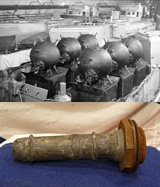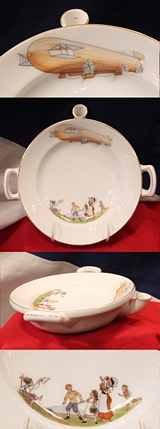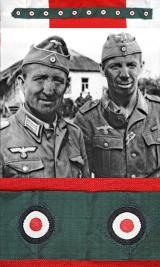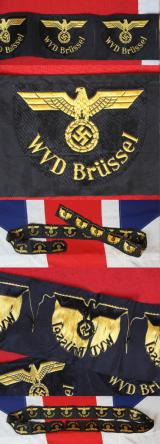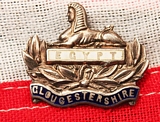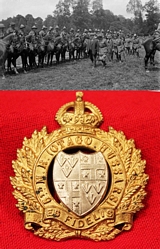WW1 / WW2 / 20th Century
Very Rare Aeronautical Stamps. Canada: 1918 (Aug) Aero Club of Canada 25c "flaming Zeppelin" Stamps
label CLP2 tete-beche pair, perfectly centred, one stamp very lightly mounted, the other unmounted, one with surface tear. A scarce collectable stamp from the very earliest Canadian Airmail service. We have seen good single stamps of this type achieving prices up to $1100. We are pricing as for a single stamp with it's matching companion free. read more
365.00 GBP
Solid Silver Hallmarked L.Z.127 Graf Zeppelin Airship Aerospace Medal 1929 World Flight Issue
FRIEDRICHSHAFEN, STADT Medal 1929 (stamped by Josef Bernhart) on the 1st world flight of the LZ 127 "Graf Zeppelin". Busts of Zeppelin and Eckener l. Rev: Zeppelin. Beautiful patina. 36mm; 25g excellent condition Edge stamped hallmark: PREUSS. STATE COIN. SILVER 900
The around-the-globe flight of the German-built and -operated hydrogen-filled airship began in August 1929 at Lakehurst Naval Air Station in New Jersey, where it ended 21 days, five hours and 31 minutes later after covering some 20,651 miles in four legs.
Sponsored in part by Newspaper baron William Randolph Hearst, one of the worlds most influential newspaper owners and also one of the richest men in the world, in his day. His notoriety was also subject to a biographical movie loosely based on his life, Citizen Kane, directed by Orson Welles. The result of which caused W.R.Hearst to spend many years trying, and in many ways succeeding, to destroy Orson Welles' career.
Costs for the flight were subsidized by the transport of souvenir mail to and from the stops in Lakehurst, Friedrichshafen, Tokyo, and Los Angeles, and these pieces are highly collectible today. 1929. it was originally owned and run by Deutsche Luftschiffahrts-Aktiengesellschaft German Airship Transportation Corporation Ltd But in 1935 Reich Minister of Aviation, Hermann Göring insisted that a new agency be created to extend Party control over LZ Group. A personal rivalry between Göring and Propaganda Minister Joseph Goebbels also played a role. Deutsche Zeppelin-Reederei was therefore incorporated on 22 March 1935 as a joint venture between Zeppelin Luftschiffbau, the Ministry of Aviation, and Deutsche Lufthansa.
LZ 127 Graf Zeppelin was a German passenger-carrying, hydrogen-filled rigid airship which flew from 1928 to 1937. It was designed and built to show that intercontinental airship travel was practicable. Its operational history included several long flights, such as a polar exploration mission, a round-the-world trip, trips to the Middle East and the Americas (operating five years of regular passenger and mail flights from Germany to Brazil), and latterly being used as a propaganda vehicle for the ruling Nazi Party. The airship was withdrawn from service following the Hindenburg disaster.
Although to most this piece looks like a coin, in Germany and also in France, medals could come in the table medal variety, not ever meant to be worn but for display in a table cabinet or mounted and framed. Awarded for the same reason as a medal made to be only worn on the person, as all British medals are.
Photo in the gallery of the medals with the armband of the Ortsgruppenleiter, from whom the medals came from all sold seperately read more
225.00 GBP
Solid Silver Hallmarked L.Z.127 Graf Zeppelin Airship Aerospace Medal 1928 Issue
Zeppelin Aerospace medal in solid siver.
Silver medal 1928 (J. Bernhart) Airship LZ 127 "Graf Zeppelin". Half-length portraits of Zeppelin and Eckener side by side to the left / Airship over ocean. Edge stamped hallmark: PREUSS. STATE COIN. SILVER 900 FINE. 36 mm, 24.37 g Fine patina,
L.Z.127 Graf Zeppelin airship medals, one awarded in 1928 the other 1929. Sold separately, acquired with the Ortsgruppenleiter's armband taken as war souvenirs in 1945, sadly the name of the NSDAP Ortsgruppenleiter and his medals was not noted at the time.
LZ127 it was originally owned and run by Deutsche Luftschiffahrts-Aktiengesellschaft German Airship Transportation Corporation Ltd But in 1935 Reich Minister of Aviation, Hermann Göring insisted that a new agency be created to extend Party control over LZ Group. A personal rivalry between Göring and Propaganda Minister Joseph Goebbels also played a role.Deutsche Zeppelin-Reederei was therefore incorporated on 22 March 1935 as a joint venture between Zeppelin Luftschiffbau, the Ministry of Aviation, and Deutsche Luft Hansa.
LZ 127 Graf Zeppelin was a German passenger-carrying, hydrogen-filled rigid airship which flew from 1928 to 1937. It was designed and built to show that intercontinental airship travel was practicable. Its operational history included several long flights, such as a polar exploration mission, a round-the-world trip, trips to the Middle East and the Americas (operating five years of regular passenger and mail flights from Germany to Brazil), and latterly being used as a propaganda vehicle for the ruling Nazi Party. The airship was withdrawn from service following the Hindenburg disaster.
Photo in the gallery of the medals with the armband of the Ortsgruppenleiter, from whom the medals came from all sold seperately
Although to most this piece looks like a coin, in Germany and also in France, medals could come in the table medal variety, not ever meant to be worn but for display in a table cabinet or mounted and framed. Awarded for the same reason as a medal made to be only worn on the person, as all British medals are. read more
160.00 GBP
A Most Rare Original WW2 German Hertz Horn MineTrigger
Made in lead alloy a tube that was filled with glass liners containing bio chromatic chemicals in order to break upon contact and ignite the mine in order to sink the allied ship.
Used on such as the German Type GZ (the German designation was UMA). It had a small charge of only 66 pounds of high explosive because it was intended as an anti-submarine mine. Anti-shipping mines had much larger charges.
Inert and completely safe. read more
145.00 GBP
A Very Good German 1900's & WW1 Porcelain Zeppelin Plate Warmer
Items made in Germany with representations of the pre war and WW1 Zeppelin airships are scarce and much sought after. This is a most unusual very early piece of very nice quality, but also a funtional piece of finest German porcelain. The best-known German strategic bombing campaign during World War I was the campaign against England, although strategic bombing raids were carried out or attempted on other fronts. The main campaign against England started in January 1915 using airships. From then until the end of World War I the German Navy and Army Air Services mounted over 50 bombing raids on the United Kingdom. These were generally referred to as "Zeppelin raids": although both Zeppelin and Sch?tte-Lanz airships were used, the Zeppelin company was much better known and was responsible for producing the vast majority of the airships used. Weather conditions and night flying conditions made airship navigation and therefore bombing accuracy difficult. Bombs were often dropped miles off target (one raid on London actually bombed Hull) and accurate targeting of military installations was impossible. The civilian casualties made the Zeppelins an object of hatred, and they were widely dubbed ?baby-killers?. With the development of effective defensive measures the airship raids became increasingly hazardous, and in 1917 the airships were largely replaced by aeroplanes.
Although the direct military effect of the raids was small, they caused widespread alarm, leading to the diversion of substantial resources from the Western Front and some disruption to industrial production. Concern about the conduct of defence against the raids, the responsibility for which was divided between the Admiralty and the Army, led to a parliamentary inquiry under Jan Smuts, whose report was to lead to the creation of the Royal Air Force on 1 April 1918. The defence organisation developed by the British was an important precursor of the fighter direction system that would prove vital in winning the Battle of Britain. The raids were also influential because they led to an overestimation of both the material and psychological effects of the bombing of cities.
Airships made about 51 bombing raids on England during the war. These killed 557 and injured another 1,358 people. More than 5,000 bombs were dropped on towns across Britain, causing ?1.5 million in damage. 84 airships took part, of which 30 were lost, either shot down or lost in accidents. Aeroplanes carried out 27 raids, dropping 246,774 lb (111,935 kg) of bombs for the loss of 62 aircraft, resulting in 835 deaths, 1972 injured read more
245.00 GBP
A Scarce Pattern of Imperial German 121st infantry Officers Sword XIII Royal Wurtemberg Corps
Bronze hilt with folding guard. Overall very nice condition and beautiful regimental markings to hilt and scabbard. Made by Gebruder Wayersberg of Solingen. Scabbard bottom section lacking. Potentially used by a Wurttemberg officer who knew or fought with another Wurttemberg officer at the same time, Erwin Rommel. On mobilization in 1914, the corps was subordinated to the 5th Army and saw action on the Western Front. It was transferred to the 6th Army during the Race to the Sea. In October 1914, the corps headquarters formed Corps Fabeck, which by the end of the month had become a provisional army group, commanding XV Corps, II Bavarian Corps and Corps Urach. In November, the XIII Army Corps was transferred from the 6th Army to the 9th Army on the Eastern Front. By 1916, the corps had returned to the Western Front and was subordinated to the 4th Army under Army Group Crown Prince Rupprecht. From April 1917 to March 1918, the corps commanded Group Caudry, another provisional command. In September 1918, it took over command of Group Ebene under Army Group Duke Albrecht of Württemberg, and commanded Group Ebene until war's end.
It was still in existence at the end of the war in Armee-Abteilung C, Heeresgruppe Gallwitz on the Western Front.
Württemberg mountain battalion
In 1915 a Württemberg mountain battalion was also formed, on drafts from the Württemberg line regiments, which became a part of the Alpenkorps division in 1917. This was the unit in which the young Erwin Rommel distinguished himself on the Romanian and Italian fronts, winning the Pour le Mérite (Imperial German equivalent of the Victoria Cross) at the Batlle of the Isonzo in 1917. Erwin Rommel was undoubtedly one of the finest generals of the Second World War, his strategic mind and patient approach led his men to victory after victory early in the war. But, while his fame and glory came as a General and Field Marshal, it was as a Lieutenant in the First World War that he earned his greatest honor.
Rommel started out the war in command of a reserve artillery company but immediately transferred to the 124th Wurtemberg Infantry regiment. By the middle of August 1914, he was in contact with the French, and showed his daring and genius in combat. The II Battalion, to which Rommel’s platoon was attached, halted at Bleid, a small French farming town. They sent out scouting parties, testing the various hedgerows and farms for French resistance.
Taking just three men from his platoon Rommel advanced to the edge of the town, where they found 15 French soldiers taking a nervous breakfast in the dense fog. Rather than retrieving his full platoon and assaulting, Rommel gave the order to open fire, and this four man party scattered the French troops, killing 5 of them. After receiving a stiff bout of rifle fire in response, he and his men returned to their platoon, then advanced with the rest of the battalion. read more
325.00 GBP
A Most Scarce Strip of 10 Heer EM/NCO Overseas M43 Cap Cockade Insignia
Made of a a machine embroidered cotton, this insignia is in very good un-issued condition! The colours are still vibrant! Features tri-colour national emblem. Perfect for any collection or display of German WW2 Very rare to find an un-issued strip of any form of German Bevo uniform insignia. A most rare discovery read more
375.00 GBP
An Amazing & Most Rare Un-Issued Fully Intact Strip of 18 Third Reich Reichsbahn Ärmeladler – WVD BrusselsArm Badges of the German Railways Armed Forces Traffic Directorate (WVD), Brussels Division
(Ärmeladler) of the WVD (Wehrmachtverkehrsdirektion) Brussels. WVD, " Wehrmacht Verkehrsdirektion" (Armed-forces Traffic-directorate),
Arm badge worn by personnel of the German Railways Armed Forces Traffic Directorate (WVD), Brussels Division. A machine woven, right facing eagle with outstretched wings and a wreathed, mobile swastika in its talons, positioned above the arching script, "WVD Brüssel." All of the threads are bright golden-yellow, against a half-moon. The insignia indicates service with the "Brüssel" division of the "Wehrmachtverkehrsdirektion.". Still on their original un-cut factory roll backing material.
WVD = Wehrmachtverkehrsdirektion
These badges were introduced in September 1941 superseding the German Railway cuff-titles, themselves only introduces some seven months previously, in February 1941. They were worn on the left upper arm of the uniform and usually cut or folded to produce a pointed or curved lower edge. The badges combined the German national eagle emblem above the initials of the relevant Railway Directorate, of which there were four (WVD, HVD, RBD & RVD), plus the specific Railway Division, which was usually based on large and important marshalling yards or railway areas. This branch of the Wehrmacht under the Nazi regime is responsible for controlling the operation of the national railways . It was created during the reorganization in 1937 of the Deutsche Reichsbahn into four directories.
It moved to Paris on June 21 , 1940 and the first contacts between SNCF and WVD took place on June 26 , 1940. The headquarters of the WVD was first in 36 of Avenue Kléber, then at 29,rue de Berri, in the 8 th arrondissement, near the Champs Elysées. It is the vice-president of the direction of the regional Reichsbahn of Hanover, Hans Münzer, who was named supreme commander (Kommandeur) of this authority of control of the French railways.
In August 1940, the operation of the network in occupied areas , outside Alsace-Lorraine, is transferred as a whole to the WVD located in Paris. A WVD is also installed in Brussels, which has jurisdiction over part of the North of France.
The SNCF retained ownership of the equipment which remained to it after the German requisitions, its trains were driven by French railway workers, but it was placed under the surveillance of WVD which subjected the personnel to German war laws and imposed the presence of 6500 German railway workers in stations, depots and operating sites responsible for ensuring the proper functioning of the company on site. Its goal is then to restart the French railway services in order to optimize its transport time, allow its use by the German forces, contribute to the German economy and among other things to continue to provide support to the ' invasion of North Africa . For these purposes, prisoners of war who have the skills of railway workers are released. It will then transit via French railways no less than 45 million tonnes of minerals between Italy and Germany Individual examples now sell for around £65 to £95 each read more
1245.00 GBP
A Very Good WW1 Gloucester Regt. Sterling Silver & Blue and White Enamel Military Sweetheart Brooch
The Gloucestershire Regiment was an infantry regiment of the British Army. Nicknamed "The Glorious Glosters", the regiment carried more battle honours on their regimental colours than any other British Army line regiment. During the course of the war, the regiment raised 25 battalions, seeing service on the Western Front, Gallipoli, Macedonia, Mesopotamia, Persia and Italy. Battle Honours gained in WW1; The Great War (25 battalions): Mons, Retreat from Mons, Marne 1914, Aisne 1914 '18, Ypres 1914 '15 '17, Langemarck 1914 '17, Gheluvelt, Nonne Bosschen, Givenchy 1914, Gravenstafel, St Julien, Frezenberg, Bellewaarde, Aubers, Loos, Somme 1916 '18, Albert 1916, '18, Bazentin, Delville Wood, Pozi?res, Guillemont, Flers-Courcelette, Morval, Ancre Heights, Ancre 1916, Arras 1917 '18, Vimy 1917, Scarpe 1917, Messines 1917 '18, Pilckem, Menin Road, Polygon Wood, Broodseinde, Poelcappelle, Passchendaele, Cambrai 1917 '18, St Quentin, Bapaume 1918, Rosi?res, Avre, Lys, Estaires, Hazebrouck, Bailleul, Kemmel, B?thune, Drocourt-Qu?ant, Hindenburg Line, ?p?hy, Canal du Nord, St Quentin Canal, Beaurevoir, Selle, Valenciennes, Sambre, France and Flanders 1914?18, Piave, Vittorio Veneto, Italy 1917?18, Struma, Doiran 1917, Macedonia 1915?18, Suvla, Sari Bair, Scimitar Hill, Gallipoli 1915?16, Egypt 1916, Tigris 1916, Kut al Amara 1917, Baghdad, Mesopotamia 1916?18, Persia 1918 read more
85.00 GBP
Superb WW1 Slouch Hat Badge of the 5th Mounted Rifle Ortago Hussars
A super original badge of one of the great and heroic New Zealand Horse Regiments. Probably for officers as it is gilded and manufactured with a separate silver central shield attached. Bears a small makers affixed label, Gaunt of London. The Otago Mounted Rifle Regiment was a New Zealand Mounted Regiment formed for service during the Great War. It was formed from units of the Territorial Force consisting of the 5th Mounted Rifles (Otago Hussars) the 7th (Southland) Mounted Rifles and the 12th (Otago) Mounted Rifles. They saw service during the Battle of Gallipoli, with the New Zealand Mounted Rifles Brigade and was later withdrawn to Egypt. They later left the brigade and served in served in France with the New Zealand Division becoming the only New Zealand Mounted troops to serve in France. Battle of Gallipoli
Battle of Flers - Courcelette. 15-22 Sep 1916.
Battle of Morval. 25-28 Sep 1916.
Battle of Le Transloy. 1-18 Oct 1916.
Battle of Messines. 7-14 Jun 1917.
Battle of Polygon Wood. 26 Sep - 3 Oct 1917.
Battle of Broodseinde. 4 Oct 1917.
Battle of Passchendaele. 12 Oct 1917.
Battle of Arras. 28 Mar 1918.
Battle of the Ancre. 5 Apr 1918.
Battle of Albert. 21-23 Aug 1918.
Battle of Bapaume. 31 Aug - 3 Sep 1918.
Battle of Havrincourt. 12 Sep 1918.
Battle of the Canal du Nord. 27 Sep - 1 Oct 1918.
Battle of Cambrai. 8-9 Oct 1918.
Pursuit to the Selle. 9-12 Oct 1918.
Battle of the Selle. 17-25 Oct 1918.
Battle of the Sambre. 4 Nov 1918, including the Capture of Le Quesnoy. read more
295.00 GBP





